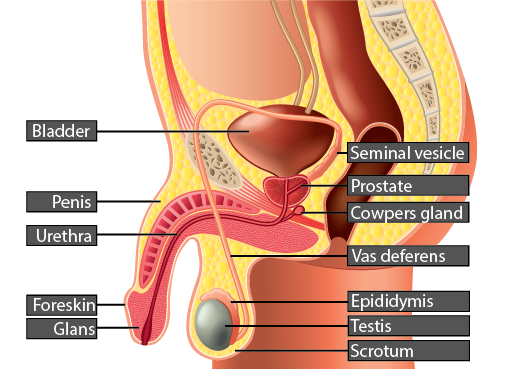Male Reproductive Anatomy
Men are fertile from puberty until old age. Each day, men produce around 200 million sperm (100 million in each testicle). Once inside the reproductive tract sperm can survive up to 5-7 days (and even longer in some instances).
The male reproductive system is responsible for the production of sperm, and the delivery of this sperm into the female vagina. It is also responsible for the production of the hormone testosterone. Testosterone influences secondary sex characteristics such as facial, pubic and body hair, a deep voice, and bodymass composition.

PENIS: Shafts of spongy tissue that become erect during arousal due to increased blood flow. Around 3-4 inches long when flaccid, and 6-8 inches long when erect. Inside the penis is the urethra which transports urine out of the body. At the head of the penis is the glans which is a sensitive area covered by the protective foreskin. During erection, the foreskin retracts to expose the glans. The penis has around 4,000 nerve endings and is very sensitive.
TESTES (singular, testis): Each testis is home to the continuous growth and development of sperm. As sperm mature they migrate into the epididymis where they are stored until ejaculation. At ejaculation, approximately 250 million sperm are released. This release is relatively explosive, with the average speed of semen ejaculated from the penis clocking in at 45km/hr or 28mph! The process of sperm growth and development is known as spermatogenesis and takes around 3 months. The testes also secrete the hormone testosterone. The testes are housed in the scrotum which can lengthen and contract. This is to control the temperature of the testes and protect the growing sperm.
VAS DEFERENS: The vas deferens are tubes that transport sperm out of the man’s body at ejaculation. Sperm move from the epididymis through the vas deferens up and around the bladder, through the seminal vesical, through the prostate gland and on into the urethra. On the way, sperm receive different fluids from both the seminal vesicles and the prostate gland.
SEMINAL VESICLES: A pair of glands that produce alkaline fructose-rich fluid that empties into the prostate at ejaculation. Fructose provides energy for the sperm.
PROSTATE GLAND: A gland below the bladder that produces a zinc-rich fluid at ejaculation. This fluid protects the sperm from DNA damage on their journey.
COWPERS GLANDS: A pair of small pea sized glands on either side of the prostate. They deliver small amounts of lubricative fluid during sexual arousal. This fluid provides lubrication within the urethra and also provides lubrication for the penis entering the vagina.
SPERM: Sperm are the smallest cells in the human body. They are shaped like a tadpole with a head, a midpiece and a tail. In the head of the sperm are 23 chromosomes – half of the genetic material required to form a new human.
